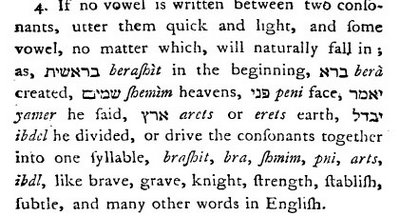One of the most hotly contested issues in Hebrew studies in the 18th centuries was what the authority of the nekudot were in reading Hebrew (specifically in reading the Bible, but also more generally in understanding Hebrew). Theology never strayed too far from the debate, even if it also touched on scientific matters. In short, those who wished to have maximal freedom in interpreting the text denigrated the nekudot, while those who wished to place maximal trust on the textus receptus idea, the Masoretic Text, lauded them. The debate touched on many other points (no pun intended!) relating to the authority of tradition and human interpretation of the Bible (seen as favorable to the Roman Catholic Church) or whether to rely on sola scriptura (a popular Protestant position). In addition, a whole crew of idiosyncratic Bible interpreters accepted only the consonants of the Hebrew Bible, and thus, of Hebrew, in order to create towers of implausible Hebrew philology some of which are truly amazing (and wrong).
In the 18th century many Hebrew grammars were published. All of them bore titles like "Hebrew Grammar...with points" or "....without points" and even some "with and without points." It was practically a genre.
One such grammar was published by an anti-pointist Anglican clergyman named Anselm Bayly (1718-1794) (here is music book he wrote for sale with some info about him). It was called A plain and complete grammar of the Hebrew language, with and without points, published in London in 1773.
In the preface Bayly writes that "the hebrew hath never been totally dead; it is alive to this day in the mouths and understanding of the wise and learned Jews who all over the world can converse with each other, and write in biblical ad well as in the rabbinical hebrew. This is a fact*
the asterisk leads to the following footnote:

Bayly continues making his case for the Jews knowing their Hebrew: "It is certain, that the hebrew was pronounced, and its grammar understood by the Doctors at Tiberius in the third and fourth century, otherwise they could not have taught it to Origen and Jerom..."
What is he getting at? That Hebrew is a living language and those who know it can read it quite easily...without nekudot. Therefore they are unecessary.
Of course he has to explain how to read Hebrew then. He does so as follows:

...

In the 18th century many Hebrew grammars were published. All of them bore titles like "Hebrew Grammar...with points" or "....without points" and even some "with and without points." It was practically a genre.
One such grammar was published by an anti-pointist Anglican clergyman named Anselm Bayly (1718-1794) (here is music book he wrote for sale with some info about him). It was called A plain and complete grammar of the Hebrew language, with and without points, published in London in 1773.
In the preface Bayly writes that "the hebrew hath never been totally dead; it is alive to this day in the mouths and understanding of the wise and learned Jews who all over the world can converse with each other, and write in biblical ad well as in the rabbinical hebrew. This is a fact*
the asterisk leads to the following footnote:

Bayly continues making his case for the Jews knowing their Hebrew: "It is certain, that the hebrew was pronounced, and its grammar understood by the Doctors at Tiberius in the third and fourth century, otherwise they could not have taught it to Origen and Jerom..."
What is he getting at? That Hebrew is a living language and those who know it can read it quite easily...without nekudot. Therefore they are unecessary.
Of course he has to explain how to read Hebrew then. He does so as follows:

...

What sort of responses this kind of thing evoke? Here is one in a book called Jonah, a faithful translation from the original: with philological and explanatory notes by George Benjoin (the only info I have so far found about him is that he taught at Jesus College and in 1794 an Act of Parliament naturalized him as a British citizen. The book itself is worth a future post, as it is filled with gems. Here is what he has to say on the matter:







No comments:
Post a Comment